All Exams >
GATE Physics >
Quantum Mechanics for GATE >
All Questions
All questions of Time Independent Perturbation Theory for GATE Physics Exam
The first-order correction to energy for the ground state of a particle-in-a-box due to a perturbation λx would be- a)λL/2
- b)λL
- c)2λL
- d)2
Correct answer is option 'A'. Can you explain this answer?
The first-order correction to energy for the ground state of a particle-in-a-box due to a perturbation λx would be
a)
λL/2
b)
λL
c)
2λL
d)
2

|
Pie Academy answered |
The ground state energy of a particle in a box is given by:

where: m is the mass of the particle, L is the length of the box, h is Planck's constant.
The perturbation is given by:

where: λ is the strength of the perturbation.
The first-order correction to the energy is given by:

Where; |ψ0⟩ is the ground state wavefunction.
The ground state wavefunction is given by:

Substituting these expressions into the equation for the first-order correction to the energy, we get:
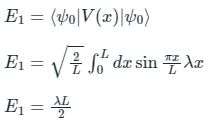
Therefore, the first-order correction to the energy for the ground state of a particle-in-a-box due to a perturbation λx is λL/2

where: m is the mass of the particle, L is the length of the box, h is Planck's constant.
The perturbation is given by:

where: λ is the strength of the perturbation.
The first-order correction to the energy is given by:

Where; |ψ0⟩ is the ground state wavefunction.
The ground state wavefunction is given by:

Substituting these expressions into the equation for the first-order correction to the energy, we get:

Therefore, the first-order correction to the energy for the ground state of a particle-in-a-box due to a perturbation λx is λL/2
The perturbation,

acts on a particle of mass m confined in an infinite square well potential

The first order to the ground state energy will be - a)

- b)

- c)ab
- d)

Correct answer is option 'C'. Can you explain this answer?
The perturbation,

acts on a particle of mass m confined in an infinite square well potential

The first order to the ground state energy will be

acts on a particle of mass m confined in an infinite square well potential

The first order to the ground state energy will be
a)

b)

c)
ab
d)


|
Pie Academy answered |
Concept:-
Perturbation Theory:
- Perturbation theory is an approximation method to find out the exact solution of any system with great accuracy.
- To break the energy correction in a particular energy level, we have to disturb the operator in a specific order.
- The energy correction is given by,

The perturbed energy levels upto first order are given by,

Explanation:
- The ground state wavefunction for the given potential is

- Now, the given perturbation is,

- The first-order correction in energy,
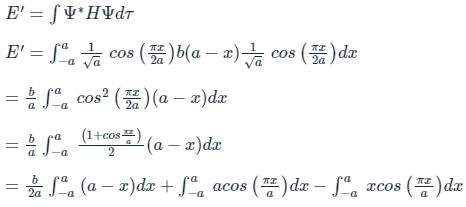
= ab
Conclusion:
Hence, the first order to the ground state energy will be ab
A perturbation of the form  is added in a 1-D box having length 0 to L. The total energy of the system corrected up to first order is;
is added in a 1-D box having length 0 to L. The total energy of the system corrected up to first order is;- a)

- b)

- c)

- d)

Correct answer is option 'C'. Can you explain this answer?
A perturbation of the form  is added in a 1-D box having length 0 to L. The total energy of the system corrected up to first order is;
is added in a 1-D box having length 0 to L. The total energy of the system corrected up to first order is;
 is added in a 1-D box having length 0 to L. The total energy of the system corrected up to first order is;
is added in a 1-D box having length 0 to L. The total energy of the system corrected up to first order is;a)

b)

c)

d)


|
Pie Academy answered |
Concept:
The energy equation for the first-order energy correction is given by,

Whereas
 (First-order Energy correction)
(First-order Energy correction)
Explanation:
For particles in a 1-D box having a length of 0 to L

in this question,
so,
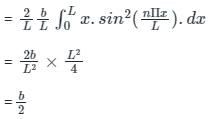
Conclusion:
Therefore the first-order energy correction is

The energy equation for the first-order energy correction is given by,

Whereas
 (First-order Energy correction)
(First-order Energy correction)Explanation:
For particles in a 1-D box having a length of 0 to L

in this question,

so,


Conclusion:
Therefore the first-order energy correction is

The first-order correction to energy for the ground state of a particle-in-a-box of length a  would be
would be- a)

- b)

- c)

- d)

Correct answer is option 'D'. Can you explain this answer?
The first-order correction to energy for the ground state of a particle-in-a-box of length a  would be
would be
 would be
would bea)

b)

c)

d)


|
Pie Academy answered |
The energy equation for the first-order energy correction is given by,

Whereas
 (First-order Energy correction)
(First-order Energy correction)

Whereas
 (First-order Energy correction)
(First-order Energy correction)- For a particle in a one-dimensional box of length a and mass m,

Explanation:
For particles in a 1-D box having a length of 0 to L

in this question,
Concept:
The energy equation for the first-order energy correction is given by,

Whereas
 (First-order Energy correction)
(First-order Energy correction)Explanation:
For particles in a 1-D box having a length of 0 to L

in this question,

so,

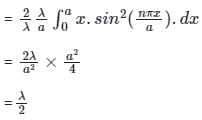
Conclusion:
- Therefore the first-order energy correction is

Conclusion:
Therefore the first-order energy correction is

When a hydrogen atom is exposed to a perturbation V = E.z, the first order correction to the wave function comes only from the orbital- a)2s
- b)2pz
- c)3py
- d)3dz2
Correct answer is option 'B'. Can you explain this answer?
When a hydrogen atom is exposed to a perturbation V = E.z, the first order correction to the wave function comes only from the orbital
a)
2s
b)
2pz
c)
3py
d)
3dz2

|
Pie Academy answered |
Concept:
Perturbation Theory:
Perturbation theory is an approximation method to find out the exact solution of any system with great accuracy.
To break the energy correction in a particular energy level, we have to disturb the operator in a specific order.
The energy correction is given by,

The perturbed energy levels upto first order are given by,

Explanation:
For a hydrogen atom that is exposed to a perturbation
V= E.z
The orbital which will contribute to the first-order correction to the wave function will be,

For 2s, 3py, and 3dz2 orbitals the first-order correction to the wave function will be
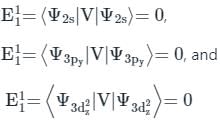
While for 2pz orbital, the first-order correction to the wave function will be

As the value of first-order correction to the wave function for 2pz orbital is non-zero, it will contribute to the first-order correction.
Conclusion:
Hence, the first-order correction to the wave function comes only from the orbital 2pz
To break the energy correction in a particular energy level, we have to disturb the operator in a specific order.
The energy correction is given by,

The perturbed energy levels upto first order are given by,

Explanation:
For a hydrogen atom that is exposed to a perturbation
V= E.z
The orbital which will contribute to the first-order correction to the wave function will be,

For 2s, 3py, and 3dz2 orbitals the first-order correction to the wave function will be

While for 2pz orbital, the first-order correction to the wave function will be

As the value of first-order correction to the wave function for 2pz orbital is non-zero, it will contribute to the first-order correction.
Conclusion:
Hence, the first-order correction to the wave function comes only from the orbital 2pz
An electron in a hydrogen atom is exposed to a perturbation V = V0rCos φ. The first order correction to the ground-state energy of the electron is- a)-V0/2
- b)4V0/15a
- c)V0/2
- d)V0
Correct answer is option 'B'. Can you explain this answer?
An electron in a hydrogen atom is exposed to a perturbation V = V0rCos φ. The first order correction to the ground-state energy of the electron is
a)
-V0/2
b)
4V0/15a
c)
V0/2
d)
V0

|
Pie Academy answered |
Concept:
- Perturbation theory is a mathematical method used to study the effects of small changes or perturbations on a physical system that is well understood in its unperturbed state.
- The idea is to start with a known, solvable system and then add a small perturbation that changes the system's behavior.
- The goal is to obtain an approximate solution to the perturbed system by treating the perturbation as a small parameter and expanding the solution in a power series in terms of this parameter.
Explanation:
To calculate the first-order correction to the ground-state energy of a hydrogen atom due to the perturbation
V = V0rCos φ, we can use time-independent perturbation theory.
The Hamiltonian for the hydrogen atom with the perturbation V is given by:
H = H0 + V
where H0 is the Hamiltonian of the unperturbed hydrogen atom and V is the perturbation.
The first-order correction to the ground-state energy (E1) is given by:
E1 = <ψ0|V|ψ0>
where ψ0 is the unperturbed ground state wave function of the hydrogen atom.
To calculate this expression, we need to express the perturbation V in terms of the position and momentum operators, which are used to construct the Hamiltonian. We can write:
V = V0rCos φ = V0 (x/r)Cos φ
where x/r is the unit vector in the direction of the electron's position vector.
We can then substitute this expression for V into the equation for E1:
E1 = <ψ0|V0 (x/r)Cos φ|ψ0>
Since the unperturbed ground state wave function of the hydrogen atom is spherically symmetric, it does not depend on the angular coordinate φ. Therefore, the angular part of the wave function can be factored out of the integral, and we can write:
E1 = <ψ0|V0 (x/r)|ψ0> ∫sinθdθ ∫dφ
where θ is the polar angle.
The integral over φ gives 2π, and we are left with:
E1 = 2π <ψ0|V0 (x/r)|ψ0> ∫sinθdθ
We can evaluate the remaining integral using the unperturbed ground-state wave function of the hydrogen atom, which is given by:
ψ0 = (1/√πa3)exp(-r/a)
where a is the Bohr radius.
Substituting this expression into the equation for E1 and using the fact that x/r = sinθcosφ, we obtain:
E1 = (2V0/3a)∫sin3θdθ = (2V0/3a)∫sinθ(1-cos2θ)d(cosθ)
We can then use the substitution u = cosθ to convert the integral to a form that can be evaluated using standard techniques:
E1 = (2V0/3a)∫(1-u2)du = (4V0/15a)
Conclusion:
Therefore, the first-order correction to the ground-state energy of a hydrogen atom due to the perturbation
V = V0rCos φ is (4V0/15a).
To calculate the first-order correction to the ground-state energy of a hydrogen atom due to the perturbation
V = V0rCos φ, we can use time-independent perturbation theory.
The Hamiltonian for the hydrogen atom with the perturbation V is given by:
H = H0 + V
where H0 is the Hamiltonian of the unperturbed hydrogen atom and V is the perturbation.
The first-order correction to the ground-state energy (E1) is given by:
E1 = <ψ0|V|ψ0>
where ψ0 is the unperturbed ground state wave function of the hydrogen atom.
To calculate this expression, we need to express the perturbation V in terms of the position and momentum operators, which are used to construct the Hamiltonian. We can write:
V = V0rCos φ = V0 (x/r)Cos φ
where x/r is the unit vector in the direction of the electron's position vector.
We can then substitute this expression for V into the equation for E1:
E1 = <ψ0|V0 (x/r)Cos φ|ψ0>
Since the unperturbed ground state wave function of the hydrogen atom is spherically symmetric, it does not depend on the angular coordinate φ. Therefore, the angular part of the wave function can be factored out of the integral, and we can write:
E1 = <ψ0|V0 (x/r)|ψ0> ∫sinθdθ ∫dφ
where θ is the polar angle.
The integral over φ gives 2π, and we are left with:
E1 = 2π <ψ0|V0 (x/r)|ψ0> ∫sinθdθ
We can evaluate the remaining integral using the unperturbed ground-state wave function of the hydrogen atom, which is given by:
ψ0 = (1/√πa3)exp(-r/a)
where a is the Bohr radius.
Substituting this expression into the equation for E1 and using the fact that x/r = sinθcosφ, we obtain:
E1 = (2V0/3a)∫sin3θdθ = (2V0/3a)∫sinθ(1-cos2θ)d(cosθ)
We can then use the substitution u = cosθ to convert the integral to a form that can be evaluated using standard techniques:
E1 = (2V0/3a)∫(1-u2)du = (4V0/15a)
Conclusion:
Therefore, the first-order correction to the ground-state energy of a hydrogen atom due to the perturbation
V = V0rCos φ is (4V0/15a).
Consider a particle on a ring that is perturbed by interacting with an applied electric field (E) with the perturbation being H' = μE cos Φ, where μ is the dipole moment. The energy levels correct upto first order are- a)

- b)

- c)

- d)

Correct answer is option 'D'. Can you explain this answer?
Consider a particle on a ring that is perturbed by interacting with an applied electric field (E) with the perturbation being H' = μE cos Φ, where μ is the dipole moment. The energy levels correct upto first order are
a)

b)

c)

d)


|
Pie Academy answered |
Concept:
- Perturbation theory is an approximation method to find out the exact solution of any system with great accuracy.
- To break the energy correction in a particular energy level, we have to disturb the operator in a specific order.
- The energy correction is given by,

- The perturbed energy levels upto first order are given by,


- For a particle in a ring, the ground state quantized energy values are,
 where ml is the magnetic quantum number.
where ml is the magnetic quantum number.Explanation:
- For a particle in a ring that is perturbed by interacting with an applied electric field (E) with the perturbation being

- For a particle in a ring, the wavefunction is given by,

- The first-order perturbed energy (E(I)) is given by,
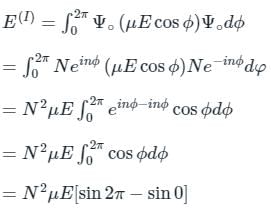
=0
Conclusion:

=0
Conclusion:
- Hence, energy levels correct upto first order are,
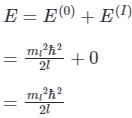
The unperturbed energy levels of a system are ε2 = 0, ε2= 2 and ε2 = 4. The second order correction to energy for the ground state in pressure of the perturbation V for which V10 = 2, V20 = 4, and V12 = 6 has been found to be- a)-6
- b)0
- c)+6
- d)-8
Correct answer is option 'A'. Can you explain this answer?
The unperturbed energy levels of a system are ε2 = 0, ε2= 2 and ε2 = 4. The second order correction to energy for the ground state in pressure of the perturbation V for which V10 = 2, V20 = 4, and V12 = 6 has been found to be
a)
-6
b)
0
c)
+6
d)
-8

|
Pie Academy answered |
Concept:
In quantum mechanics, perturbation theory is a mathematical technique used to calculate approximate solutions to the Schrödinger equation for complex quantum systems. It is especially valuable when the exact solution to the Schrödinger equation is difficult or impossible to obtain directly. Perturbation theory works by introducing a perturbing Hamiltonian operator (H') that represents a small change or perturbation to the original Hamiltonian operator (H0) describing the unperturbed system.
Explanation:
The second-order correction to the energy for nth state is given by the formula:

The square of this matrix element, (Vmn)2, represents the probability amplitude of the transition between the states ψm and ψn due to the perturbation V. It indicates how strongly these two states are coupled or interacted by the perturbation. So, [<ψm |H'| ψn>|2 = (Vmn)2.
Putting the values of Vmn in eq.(1)
The second-order correction for the ground state (n = 0) is
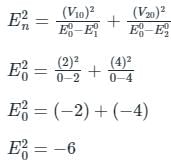
Conclusion:
Therefore, the second order perturbation for ground state is -6.
The second-order correction to the energy for nth state is given by the formula:

The square of this matrix element, (Vmn)2, represents the probability amplitude of the transition between the states ψm and ψn due to the perturbation V. It indicates how strongly these two states are coupled or interacted by the perturbation. So, [<ψm |H'| ψn>|2 = (Vmn)2.
Putting the values of Vmn in eq.(1)
The second-order correction for the ground state (n = 0) is

Conclusion:
Therefore, the second order perturbation for ground state is -6.
A perturbation Ĥ' = V0(3 cos2ϕ – 1), where V0 is a constant, is applied to a rigid rotator undergoing a rotational motion in a plane. The first order energy correction to the ground state is- a)2V0
- b)

- c)

- d)V0
Correct answer is option 'C'. Can you explain this answer?
A perturbation Ĥ' = V0(3 cos2ϕ – 1), where V0 is a constant, is applied to a rigid rotator undergoing a rotational motion in a plane. The first order energy correction to the ground state is
a)
2V0
b)

c)

d)
V0

|
Pie Academy answered |
Concept:
Perturbation Theory:
- Perturbation theory is an approximation method to find out the exact solution of any system with great accuracy.
- To break the energy correction in a particular energy level, we have to disturb the operator in a specific order.
- The energy correction is given by,

The perturbed energy levels upto first order are given by,

Explanation:-
- The wavefunction (Φ) for a rigid rotor is

the possible value of m can be

and θ can be ranged from 0 to 2π

and θ can be ranged from 0 to 2π
- For wavefunction (Φ) at ground state (m=0) will be
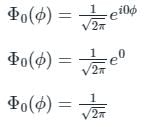
- The perturbation is given by,
Ĥ' = V0(3 cos2ϕ – 1),
where a is a constant, is added to the infinite square well potential where,
- The first-order energy correction to the ground state can be calculated as,
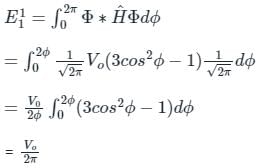
Conclusion:
Hence, the first order energy correction to the ground state is

If the perturbation H' = ax, where a is a constant, is added to an infinite square well potential

The correction to the ground state energy to first order in a is- a)

- b)aπ
- c)

- d)

Correct answer is option 'A'. Can you explain this answer?
If the perturbation H' = ax, where a is a constant, is added to an infinite square well potential

The correction to the ground state energy to first order in a is

The correction to the ground state energy to first order in a is
a)

b)
aπ
c)

d)


|
Pie Academy answered |
Perturbation Theory:
- Perturbation theory is an approximation method to find out the exact solution of any system with great accuracy.
- To break the energy correction in a particular energy level, we have to disturb the operator in a specific order.
- The energy correction is given by,

- The perturbed energy levels upto first order are given by,

Explanation:
- The perturbation is given by,
H' = ax, where a is a constant, is added to the infinite square well potential where,


- The orbital which will contribute to the first-order correction to the wave function will be,

- The Hamiltonian operator (H) is given by,

- The correction to the ground state energy to first order can be calculated as,

- The ground state wavefunction for an infinite square well potential is,

Now, the ground state wavefunction for 0≤x≤π will be


- The correction to the ground state energy to first order in a can be calculated as,
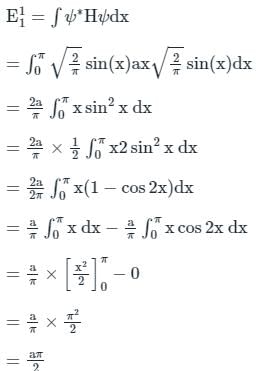
Conclusion:
The correction to the ground state energy to first order in a is 

Chapter doubts & questions for Time Independent Perturbation Theory - Quantum Mechanics for GATE 2025 is part of GATE Physics exam preparation. The chapters have been prepared according to the GATE Physics exam syllabus. The Chapter doubts & questions, notes, tests & MCQs are made for GATE Physics 2025 Exam. Find important definitions, questions, notes, meanings, examples, exercises, MCQs and online tests here.
Chapter doubts & questions of Time Independent Perturbation Theory - Quantum Mechanics for GATE in English & Hindi are available as part of GATE Physics exam.
Download more important topics, notes, lectures and mock test series for GATE Physics Exam by signing up for free.
Quantum Mechanics for GATE
77 videos|19 docs|1 tests
|

Contact Support
Our team is online on weekdays between 10 AM - 7 PM
Typical reply within 3 hours
|
Free Exam Preparation
at your Fingertips!
Access Free Study Material - Test Series, Structured Courses, Free Videos & Study Notes and Prepare for Your Exam With Ease

 Join the 10M+ students on EduRev
Join the 10M+ students on EduRev
|

|
Create your account for free
OR
Forgot Password
OR
Signup to see your scores
go up within 7 days!
Access 1000+ FREE Docs, Videos and Tests
Takes less than 10 seconds to signup









